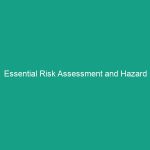Introduction
Good morning team! Today, we’re going to discuss an important topic that affects us all—stress management in the workplace. Understanding and managing stress is crucial for our overall Safety and well-being. When we know how to handle stress, we not only improve our mental health but also enhance our performance and Safety on the job. So let’s dive in and explore why effective stress management is essential for all of us.
Understanding Essential Stress Management Guidelines
Essential stress management guidelines refer to practices and techniques that help individuals cope with stress effectively. Stress can arise from various sources, including workload, interpersonal relationships, and environmental factors. In the workplace, unmanaged stress can lead to burnout, decreased productivity, and even safety incidents. It’s vital to recognize that stress isn’t just a personal issue; it impacts our entire team and the workplace Environment.
Many people believe that stressing about work is normal and unavoidable. However, it’s important to understand that while some stress can be motivating, excessive stress can hinder our performance and safety. By implementing effective stress management techniques, we can cultivate a healthier work environment that promotes well-being.
Key Hazards, Risks, and Safety Considerations
Stress can lead to several Hazards and risks in the workplace, including:
- Increased accidents: Stress can impair focus and decision-making, increasing the likelihood of accidents.
- Reduced communication: Stress can lead to misunderstandings and poor communication among team members.
- Health issues: Chronic stress can contribute to serious health problems, such as heart disease and mental health disorders.
Ignoring the importance of stress management can have real-world consequences. For example, a stressed employee may overlook safety protocols or misinterpret instructions, leading to potential hazards. By recognizing these risks, we can take proactive steps to improve our Workplace Safety culture.
Best Practices, Procedures, & Actionable Advice
Here are some effective stress management techniques that can be easily applied in our daily routines:
1. Develop Healthy Coping Mechanisms
It’s crucial to find healthy ways to cope with stress. This could include:
- Mindfulness Meditation: Take a few minutes each day to practice mindfulness. This can help you stay present and reduce anxiety.
- Physical Activity: Regular exercise is a powerful stress reliever. Aim for at least 30 minutes of physical activity a few times a week.
- Deep Breathing Exercises: Practice deep breathing techniques to calm your mind and body when feeling overwhelmed.
2. Foster Open Communication
Encouraging open communication within the team can help reduce stress. Implementing regular check-ins can help employees feel supported. Here are some strategies:
- Weekly Team Meetings: Use this time to discuss workloads and any challenges team members are facing.
- One-on-One Check-Ins: Schedule individual meetings to provide a space for employees to express their concerns.
3. Set Realistic Goals
Setting achievable goals can help prevent overwhelm. Ensure that workload expectations are manageable and revisit them regularly:
- Prioritize Tasks: Encourage the use of to-do lists to prioritize daily tasks effectively.
- Break Down Projects: Divide larger projects into smaller, more manageable tasks to reduce feelings of being overwhelmed.
4. Utilize Employee Assistance Programs (EAP)
Many organizations offer Employee Assistance Programs that provide counseling and support services. Encourage employees to utilize these resources for additional help with stress management.
5. Create a Positive Work Environment
A supportive and positive work culture can significantly reduce stress. Consider implementing the following:
- Recognition Programs: Celebrate employee achievements to foster morale and motivation.
- Team-Building Activities: Organize activities that promote teamwork and camaraderie among employees.
Real-World Example:
Consider the case of a manufacturing team that implemented a weekly wellness break. During these breaks, team members were encouraged to engage in stress-relief activities, such as yoga or guided meditation. As a result, the team reported lower stress levels, improved communication, and a noticeable decrease in workplace accidents.
Regulations, Standards, and Compliance
Understanding the Regulations surrounding Workplace Health and safety is vital. Regulations such as OSHA‘s General Duty Clause require employers to provide a work environment free from recognized hazards, including stress-related risks. Compliance with these regulations not only protects employees but also enhances overall Workplace Safety and productivity.
By adhering to these guidelines, employers can create a supportive environment that prioritizes mental health and well-being.
Employee Engagement & Discussion
Now, let’s open the floor for discussion. Here are a few questions to consider:
- What specific challenges have you encountered related to stress in our workplace?
- What strategies have you found effective in managing your stress?
- How can we support each other better in reducing workplace stress?
Your feedback and insights are invaluable as we work together to improve our workplace culture.
Conclusion & Key Takeaways
In summary, managing stress effectively is essential for our safety and well-being at work. By adopting essential stress management guidelines, we can mitigate risks, enhance productivity, and foster a healthier workplace culture. Remember, taking care of our mental health is just as important as physical safety.
Thank you for your attention and commitment to making our workplace safer and more supportive. Let’s prioritize our well-being and continue to support each other in managing stress effectively!


